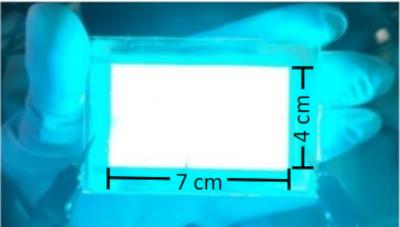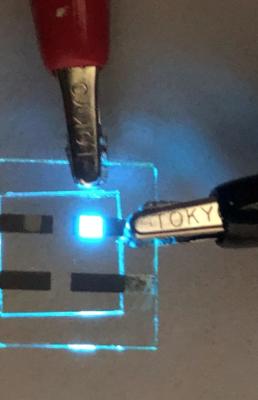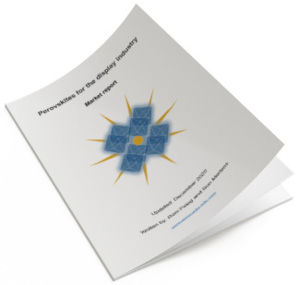Researchers develop strategy for perovskite-based blue LEDs
A Florida State University research team, led by FSU Professor of Chemistry Biwu Ma, has developed a simple and effective approach to create an efficient and stable blue light from metal halide perovskites.
Scientists have already created highly efficient and stable perovskite-based LEDs for green and red light, but an efficient and stable blue light has been difficult to achieve. Blue light requires a lot of power, and the blue color purity often decreases over time. An efficient and stable blue light is crucial for creating white light.
Researchers successfully tackle the stability issue of perovskite LEDs
Perovskite LEDs can be produced quite easily and at low cost. They show great promise as they are lightweight and can offer flexibility compared to OLEDs, with color purity and tunability similar to LEDs based on III-V semiconductors. However, the poor device stability of perovskite LEDs will have to be overcome before commercial applications can emerge. Typical lifespans of perovskite LEDs are on the order of 10 to 100 hours. In contrast, the minimum lifetime required for an OLED display is 10,000 hours. It is currently challenging to reach this threshold, as halide perovskite semiconductors can be intrinsically unstable due to the ionic nature of their crystal structures—the ions can move around when voltages are applied to the LEDs, leading to material degradation.
In their recent work, a research group led by Prof. Di Dawei and Prof. Zhao Baodan at the College of Optical Science and Engineering of Zhejiang University discovered that by using a dipolar molecular stabilizer, it is possible to make efficient and stable perovskite LEDs with ultralong lifetimes, satisfying the demands of commercial applications. The research was carried out in collaboration with the research groups of Prof. Li Cheng at Xiamen University, Prof. Hong Zijian at Zhejiang University, and Prof. Li Weiwei at NUAA and formerly at Cambridge University.
Researchers develop a method to achieve large-area efficient perovskite LEDs
A research team at Seoul National University, led by Prof. Tae-Woo Lee, has developed highly efficient large-area perovskite light-emitting diodes (PeLEDs) with an external quantum efficiency (EQE) of 22.5% and pixel size of 102 mm2.
Professor Tae-Woo Lee's research team developed the scalable coating method of perovskite nanocrystals to make uniform large-area emitting films that helped fabricate these highly efficient large-area PeLEDs.
Researchers develop novel method to fabricate perovskite-based light-emitting diodes using quantum confinement
Researchers from The Hong Kong University of Science and Technology, Heilongjiang University, City University of Hong Kong and Sun Yat-sen University have developed a novel technique to fabricate perovskite-based light-emitting diodes using quantum confinement.
According to theory, by adjusting the compositions of the halide being used, i.e., iodine, bromine, and chlorine, the color of the emission may be fine-tuned. Nevertheless, color instability caused by migration of ions and separation in blended halides impedes the future development of perovskite-based LEDs, particularly blue perovskite-based LEDs, which require significantly higher voltages for proper operation. A potential strategy for achieving color controllability in perovskite-based LEDs is to use perovskite-based nanostructures which utilize quantum confinement.
Applications of perovskite materials in the display industry
This article was extracted from the Perovskite for Displays market report.
Given perovskites materials' unique optical properties, these materials are being intensively researched for both photovoltaic and display applications (as well as several others). In this article we will take a look into the possible application areas in the display industry that can benefit from perovskite materials.
Perovskite QDs
Perovskite-based QDs (PerQDs) are considered a viable Cd-free alternative for display applications, with high PL quantum yields, wide wavelength tunability and ultra-narrow band emission. The main advantages of PerQDs are:
- Low cost
- High performance
- RoHS compliance (despite the lead content)
Researchers demonstrate large-area sky-blue perovskite LEDs
A research group, led by Prof. XIAO Zhengguo from the University of Science and Technology of China (USTC) of the Chinese Academy of Sciences, has developed large-area and efficient sky-blue perovskite light-emitting diodes (PeLEDs) by blade-coating supersaturated perovskite solution.

Metal halide PeLEDs can achieve high luminance at low voltage due to their high electrical conductivity, making them ideal for the next generation of energy-saving lighting. Blue/sky-blue PeLEDs are essential for white lighting, but the EQE of blue light is relatively low since the crystallization process of such perovskite films is difficult to control, which results in poor film quality.
The Perovskite for Displays Market Report updated to April 2022
Perovskite-Info is proud to announce an update to our Perovskite for the Display Industry Market Report. This market report, brought to you by the world's leading perovskite and OLED industry experts, is a comprehensive guide to next-generation perovskite-based solutions for the display industry that enable efficient, low cost and high-quality display devices. The report is now updated to April 2022.
Reading this report, you'll learn all about:
- Perovskite materials and their properties
- Perovskite applications in the display industry
- Perovskite QDs for color conversion
- Prominent perovskite display related research activities
The report also provides a list of perovskite display companies, datasheets and brochures of pQD film solutions, an introduction to perovskite materials and processes, an introduction to emerging display technologies and more.
Researchers achieve large-area and efficient sky-blue perovskite LEDs via blade-coating
Researchers from Beihang University and the University of Science and Technology of China (USTC) of the Chinese Academy of Science have developed efficient and large-area sky-blue Perovskite-based LEDs, through blade-coating supersaturated precursors.
This approach results in nucleation in the solution phase with much higher nucleation sites, and a faster crystallization rate. The uniform films formed by this method reportedly exhibit smaller grain size, lower trap density, and higher radiative recombination rate.
Researchers advance towards creating more stable blue perovskite LEDs
Researchers from the Okinawa Institute of Science and Technology Graduate University (OIST) have developed blue LEDs based on metal halide perovskites, that, for the first time, uses asymmetrical bridges to hold the layers of perovskite together, creating a more stable structure.

'Perovskites have the potential to be a real game-changer in the lighting industry,' said first author Dr. Yuqiang Liu, a former post-doctoral researcher in the OIST Energy Materials and Surface Sciences Unit and currently a professor at Qingdao University, China. 'In only a few short years, the efficiency of perovskite LEDs ' how well they can transfer electrical energy into light energy ' has shot up to a level that rivals traditional LEDs, and soon will surpass them.'
The Perovskite for Displays Market Report updated to January 2022
Perovskite-Info is proud to announce an update to our Perovskite for the Display Industry Market Report. This market report, brought to you by the world's leading perovskite and OLED industry experts, is a comprehensive guide to next-generation perovskite-based solutions for the display industry that enable efficient, low cost and high-quality display devices. The report is now updated to January 2022.
Reading this report, you'll learn all about:
- Perovskite materials and their properties
- Perovskite applications in the display industry
- Perovskite QDs for color conversion
- Prominent perovskite display related research activities
The report also provides a list of perovskite display companies, datasheets and brochures of pQD film solutions, an introduction to perovskite materials and processes, an introduction to emerging display technologies and more.
Pagination
- Previous page
- Page 5
- Next page




